

Compact Muon Solenoid
LHC, CERN
| CMS-PAS-HIN-21-016 | ||
| Multiplicity dependence of charm baryon and meson production in pPb collisions at 8.16 TeV | ||
| CMS Collaboration | ||
| 28 March 2023 | ||
| Abstract: Measurements of charm baryon, Λ+c, and meson, D0, production yields in proton-lead collisions at a nucleon-nucleon center-of-mass energy of 8.16 TeV are presented over a wide range of event charged track multiplicities. The data were collected in 2016 with the CMS experiment with an integrated luminosity of 186 nb−1. The Λ+c baryon is reconstructed from the decay channel Λ+c→K0Sp while D0 meson is reconstructed via D0→K−π+. The Λ+c baryon and D0 meson yields are extracted in several event multiplicity classes, up to the highest multiplicity of about 250 where long-range collective azimuthal correlations are observed for charm mesons. The production ratio of Λ+c to D0 is studied to explore the charm hadronization mechanism possibly in presence of a dense medium produced in high-multiplicity pPb collisions. Within uncertainties, the Λ+c-to-D0 yield ratio is found to be consistent between the highest and the lowest multiplicities investigated, unlike the previously observed ratio of Λ/¯Λ-to-K0S in pPb collisions which shows a strong multiplicity dependence. Moreover, the Λ+c-to-D0 yield ratio is smaller than the Λ/¯Λ-to-K0S one. The observation reported may indicate different event multiplicity evolution of hadronization mechanism for charm quarks than light flavor strange quarks, and provides new constraints to understand heavy flavor production and collectivity in high-multiplicity small-system collisions. | ||
|
Links:
CDS record (PDF) ;
CADI line (restricted) ;
These preliminary results are superseded in this paper, Submitted to PLB. The superseded preliminary plots can be found here. |
||
| Figures & Tables | Summary | Additional Figures | References | CMS Publications |
|---|
| Figures | |
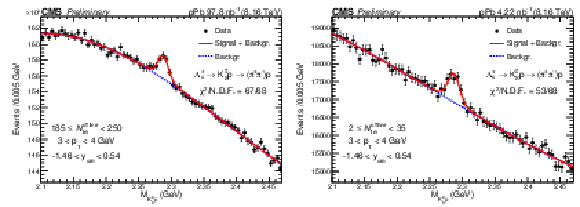
png pdf |
Figure 1:
The mass spectra and fit for Λ+c candidates with 3 <pT< 4 GeV and −1.46 <ycm< 0.54. Left: the mass spectra in the multiplicity class with 185 ≤Nofflinetrk< 250. Right: the mass spectra in the multiplicity class with 2 ≤Nofflinetrk< 35. |

png pdf |
Figure 1-a:
The mass spectra and fit for Λ+c candidates with 3 <pT< 4 GeV and −1.46 <ycm< 0.54. Left: the mass spectra in the multiplicity class with 185 ≤Nofflinetrk< 250. Right: the mass spectra in the multiplicity class with 2 ≤Nofflinetrk< 35. |
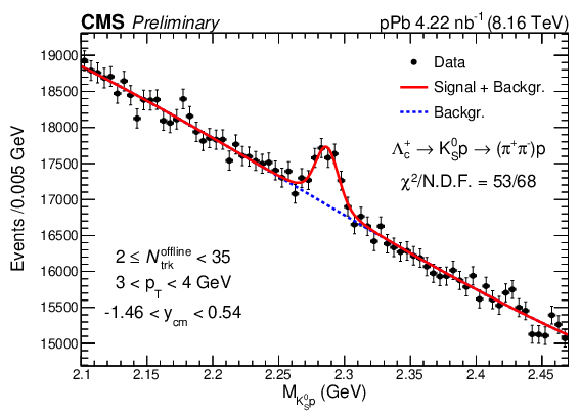
png pdf |
Figure 1-b:
The mass spectra and fit for Λ+c candidates with 3 <pT< 4 GeV and −1.46 <ycm< 0.54. Left: the mass spectra in the multiplicity class with 185 ≤Nofflinetrk< 250. Right: the mass spectra in the multiplicity class with 2 ≤Nofflinetrk< 35. |
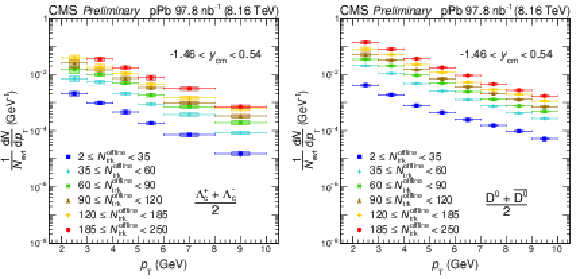
png pdf |
Figure 2:
Transverse momentum spectra for Λ+c and D0 mesons with −1.46 <ycm< 0.54 in different multiplicity classes. Left: Λ+c baryons. Right: D0 mesons. The uncertainty bars are for statistic uncertainties while the shaded areas represent the systematic uncertainties. |

png pdf |
Figure 2-a:
Transverse momentum spectra for Λ+c and D0 mesons with −1.46 <ycm< 0.54 in different multiplicity classes. Left: Λ+c baryons. Right: D0 mesons. The uncertainty bars are for statistic uncertainties while the shaded areas represent the systematic uncertainties. |
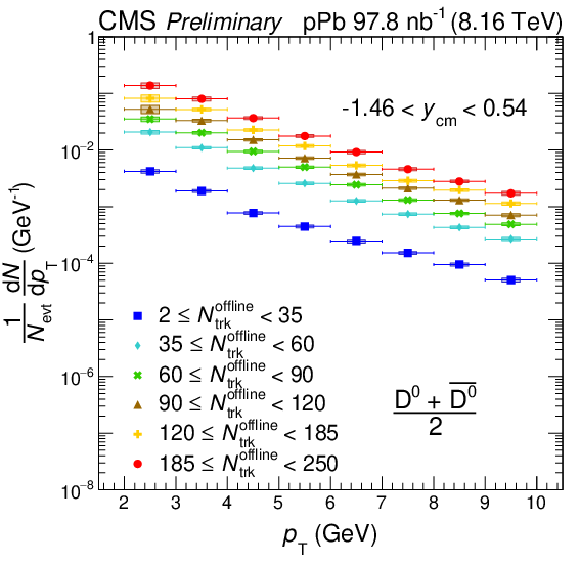
png pdf |
Figure 2-b:
Transverse momentum spectra for Λ+c and D0 mesons with −1.46 <ycm< 0.54 in different multiplicity classes. Left: Λ+c baryons. Right: D0 mesons. The uncertainty bars are for statistic uncertainties while the shaded areas represent the systematic uncertainties. |

png pdf |
Figure 3:
The ratio of Λ+c baryon to D0 meson production in pPb collisions at √sNN= 8.16 TeV with 2 ≤Nofflinetrk< 35 and 185 ≤Nofflinetrk< 250 is shown. The uncertainty bars are for statistical uncertainties while the shaded areas represent the systematic uncertainties. The grey markers are for Λ baryon to (two times) K0S meson production at √sNN= 5.02 TeV from Ref. [46]. |
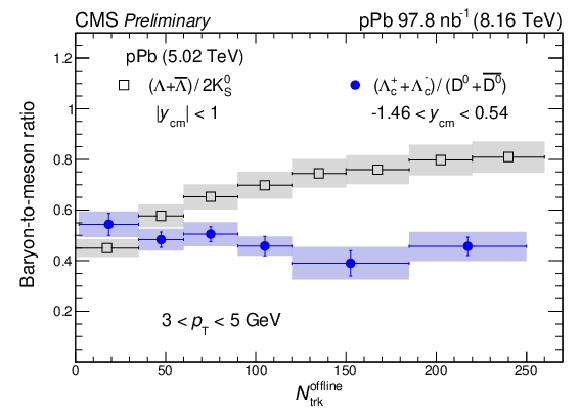
png pdf |
Figure 4:
The ratio of Λ+c baryon to D0 meson production with −1.46 <ycm< 0.54 in pPb collisions at √sNN= 8.16 TeV as a function of Nofflinetrk. The uncertainty bars are for statistical uncertainties while the shaded areas represent the systematic uncertainties. The ratio of Λ baryon to (two times) K0S meson production at √sNN= 5.02 TeV from Ref. [46] is also shown for comparisons, denoted by grey markers. |
| Tables | |

png pdf |
Table 1:
Summary for sytematic uncertainties. These uncertainties are relative values with respect to production yields. |

png pdf |
Table 2:
Summary table for nonprompt Λ+c baryons fractions relative to inclusive Λ+c baryons reconstructed in this note. The uncertainties are taken as the systematic uncertainties and details are described in Section 4. The representative range of the uncertainties is 4-14%, relative to the production yields of Λ+c baryons. |
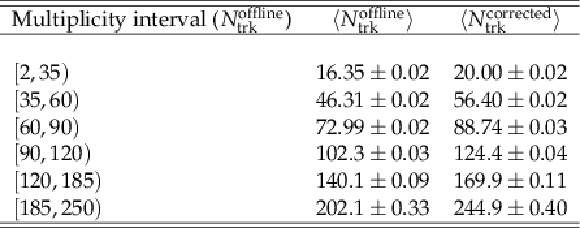
png pdf |
Table 3:
The average of multiplicity ⟨Nofflinetrk⟩ and ⟨Ncorrectedtrk⟩ in each multiplicity class. Definitions of Nofflinetrk and Ncorrectedtrk are described in in Section 2. The uncertainty for each class refers to the statistical uncertainty in the given multiplicity range. |
| Summary |
| In summary, the first measurements of Λ+c baryons and D0 mesons and their yield ratios in proton-lead collisions at a nucleon-nucleon center-of-mass energy of 8.16 TeV are presented as a function of transverse momentum and final-state multiplicity. No strong multiplicity dependence is observed for charm hadrons within the experimental uncertainties. The difference between these results for charm quarks and previous ones for light quarks might indicate coalescence processes of heavy quarks saturate earlier than those of light quarks. |
| Additional Figures | |
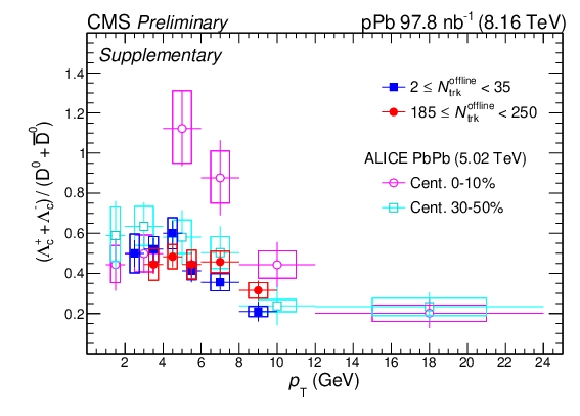
png pdf |
Additional Figure 1:
The baryon-to-meson ratio of charm hadron productions in pPb and PbPb collisions, the later from the ALICE experiment. The statistical uncertainties are represented by vertical bars and the statistical uncertainties are denoted by boxes. The ratios with multiplicity 2 ≤Nofflinetrk< 35 (blue full squares) and 185 ≤Nofflinetrk< 250 (red full circles) in pPb collisions at a nucleon-nucleon center-of-mass energy of 8.16 TeV are presented. The average number of offline tracks after tracking efficiency correction is 20.0 (250) in the multiplicity range 2 ≤Nofflinetrk< 35 (185 ≤Nofflinetrk< 250). The results with centrality 0-10% (magenta open circles) and centrality 30-50% (cyan open squares) in PbPb collisions at a nucleon-nucleon center-of-mass energy of 5.02 TeV are also shown [45]. |

png pdf |
Additional Figure 2:
The baryon-to-meson ratio of charm hadron productions in pPb and PbPb collisions, the later from the ALICE experiment. The statistical uncertainties are represented by vertical bars and the statistical uncertainties are denoted by boxes. The ratios with multiplicity 2 ≤Nofflinetrk< 35 (blue full squares) and 185 ≤Nofflinetrk< 250 (red full circles) in pPb collisions at a nucleon-nucleon center-of-mass energy of 8.16 TeV are presented. The average number of offline tracks after tracking efficiency correction 20.0 (250) in the legend corresponds to the multiplicity range 2 ≤Nofflinetrk< 35 (185 ≤Nofflinetrk< 250). The results with centrality 0-10% (magenta open circles) and centrality 30-50% (cyan open squares) in PbPb collisions at a nucleon-nucleon center-of-mass energy of 5.02 TeV are also shown [45]. |
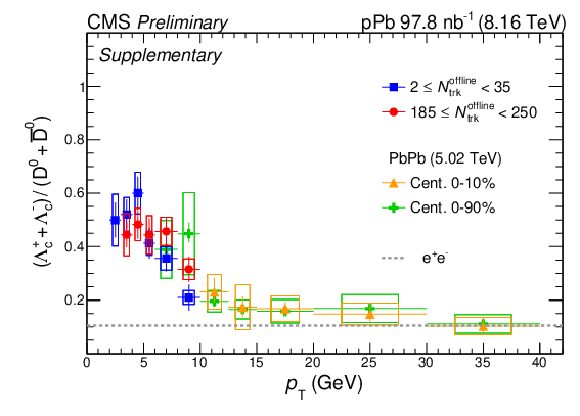
png pdf |
Additional Figure 3:
The baryon-to-meson ratio of charm hadron productions in pPb collisoins and PbPb collisions. The statistical uncertainties are represented by vertical bars and the systematic uncertainties are denoted by boxes. The ratios with multiplicity 2 ≤Nofflinetrk< 35 (blue full squares) and 185 ≤Nofflinetrk< 250 (red full circles) in pPb collisions at a nucleon-nucleon center-of-mass energy of 8.16 TeV are presented. The average number of offline tracks after tracking efficiency correction is 20.0 (250) in the multiplicity range 2 ≤Nofflinetrk< 35 (185 ≤Nofflinetrk< 250). The results with centrality 0-10% (orange full triangles) and centrality 0-90% (green full crosses) in PbPb collisions at a nucleon-nucleon center-of-mass energy of 5.02 TeV are also shown [74]. The ratio of production yields of charm hadrons in e+e− collisoins is plotted using a dashed line [75]. |

png pdf |
Additional Figure 4:
The baryon-to-meson ratio of charm hadron productions in pPb collisoins and PbPb collisions. The statistical uncertainties are represented by vertical bars and the systematic uncertainties are denoted by boxes. The ratios with multiplicity 2 ≤Nofflinetrk< 35 (blue full squares) and 185 ≤Nofflinetrk< 250 (red full circles) in pPb collisions at a nucleon-nucleon center-of-mass energy of 8.16 TeV are presented. The average number of offline tracks after tracking efficiency correction 20.0 (250) in the legend corresponds to the multiplicity range 2 ≤Nofflinetrk< 35 (185 ≤Nofflinetrk< 250). The results with centrality 0-10% (orange full triangles) and centrality 0-90% (green full crosses) in PbPb collisions at a nucleon-nucleon center-of-mass energy of 5.02 TeV are also shown [74]. The ratio of production yields of charm hadrons in e+e− collisions is plotted using a dashed line [75]. |

png pdf |
Additional Figure 5:
The baryon-to-meson ratio of charm hadron productions in pPb collisoins and PbPb collisions. The statistical uncertainties are represented by vertical bars and the systematic uncertainties are denoted by boxes. The ratios with multiplicity 2 ≤Nofflinetrk< 35 (blue full squares) and 185 ≤Nofflinetrk< 250 (red full circles) in pPb collisions at a nucleon-nucleon center-of-mass energy of 8.16 TeV are presented. The average number of offline tracks after tracking efficiency correction is 20.0 (250) in the multiplicity range 2 ≤Nofflinetrk< 35 (185 ≤Nofflinetrk< 250). The results in PbPb collisions at a nucleon-nucleon center-of-mass energy of 5.02 TeV are also shown. The ratios by the CMS experiment with centrality 0-10% are denoted by orange full triangles and the ones with centrality 0-90% denoted by green full crosses [74]. The ratios by the ALICE experiment with centrality 0-10% are represented by magenta open circles. and the ones with centrality 30-50% are represented by cyan open squares [45]. |
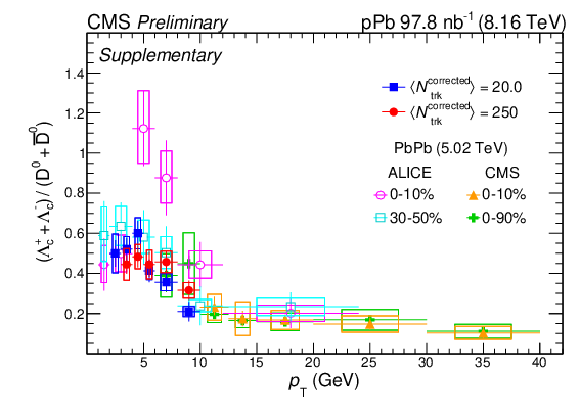
png pdf |
Additional Figure 6:
The baryon-to-meson ratio of charm hadron productions in pPb collisoins and PbPb collisions. The statistical uncertainties are represented by vertical bars and the systematic uncertainties are denoted by boxes. The ratios with multiplicity 2 ≤Nofflinetrk< 35 (blue full squares) and 185 ≤Nofflinetrk< 250 (red full circles) in pPb collisions at a nucleon-nucleon center-of-mass energy of 8.16 TeV are presented. The average number of offline tracks after tracking efficiency correction 20.0 (250) in the legend corresponds to the multiplicity range 2 ≤Nofflinetrk< 35 (185 ≤Nofflinetrk< 250). The results in PbPb collisions at a nucleon-nucleon center-of-mass energy of 5.02 TeV are also shown. The ratios by the CMS experiment with centrality 0-10% are denoted by orange full triangles and the ones with centrality 0-90% denoted by green full crosses [74]. The ratios by the ALICE experiment with centrality 0-10% are represented by magenta open circles. and the ones with centrality 30-50% are represented by cyan open squares [45]. |
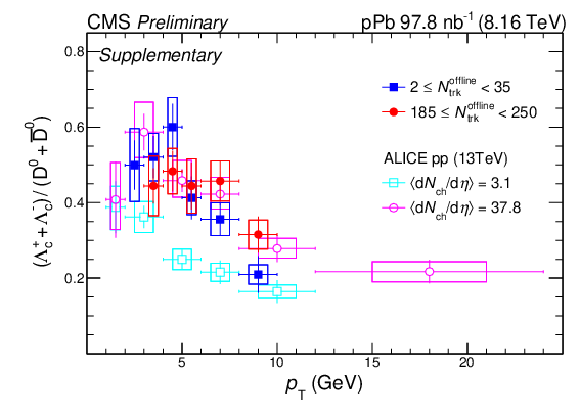
png pdf |
Additional Figure 7:
The baryon-to-meson ratio of charm hadron productions in pPb and pp collisions, the later from the ALICE experiment. The statistical uncertainties are represented by vertical bars and the systematic uncertainties are denoted by boxes. The ratios with multiplicity 2 ≤Nofflinetrk< 35 (blue full squares) and 185 ≤Nofflinetrk< 250 (red full circles) in pPb collisions at a nucleon-nucleon center-of-mass energy of 8.16 TeV are presented. The average number of offline tracks after tracking efficiency correction is 20.0 (250) in the multiplicity range 2 ≤Nofflinetrk< 35 (185 ≤Nofflinetrk< 250). The results with multiplicity ⟨dNch/dη⟩= 3.1 (magenta open circles) and ⟨dNch/dη⟩= 37.83 (cyan open squares) in pp collisions at a center-of-mass energy of 13 TeV are also shown [49]. The multiplicity dNch/dη is defined in Ref. [73]. |

png pdf |
Additional Figure 8:
The baryon-to-meson ratio of charm hadron productions in pPb and pp collisions, the later from the ALICE experiment. The statistical uncertainties are represented by vertical bars and the systematic uncertainties are denoted by boxes. The ratios with multiplicity 2 ≤Nofflinetrk< 35 (blue full squares) and 185 ≤Nofflinetrk< 250 (red full circles) in pPb collisions at a nucleon-nucleon center-of-mass energy of 8.16 TeV are presented. The average number of offline tracks after tracking efficiency correction 20.0 (250) in the legend corresponds to the multiplicity range 2 ≤Nofflinetrk< 35 (185 ≤Nofflinetrk< 250). The results with multiplicity ⟨dNch/dη⟩= 3.1 (magenta open circles) and ⟨dNch/dη⟩= 37.83 (cyan open squares) in pp collisions at a center-of-mass energy of 13 TeV are also shown [49]. The multiplicity dNch/dη is defined in Ref. [73]. |
| References | ||||
| 1 | ALICE Collaboration | Elliptic flow of charged particles in Pb-Pb collisions at 2.76 TeV | PRL 105 (2010) 252302 | 1011.3914 |
| 2 | CMS Collaboration | Measurement of the elliptic anisotropy of charged particles produced in PbPb collisions at nucleon-nucleon center-of-mass energy = 2.76 TeV | Phys. Rev. C 87 (2013) 014902 | CMS-HIN-10-002 1204.1409 |
| 3 | STAR Collaboration | Elliptic flow in Au+Au collisions at √sNN= 130 GeV | PRL 86 (2001) 402 | nucl-ex/0009011 |
| 4 | PHENIX Collaboration | Elliptic flow of identified hadrons in Au+Au collisions at √sNN= 200 GeV | PRL 91 (2003) 182301 | nucl-ex/0305013 |
| 5 | STAR Collaboration | Distributions of charged hadrons associated with high transverse momentum particles in pp and Au+Au collisions at √sNN= 200 GeV | PRL 95 (2005) 152301 | nucl-ex/0501016 |
| 6 | PHOBOS Collaboration | System size dependence of cluster properties from two- particle angular correlations in Cu+Cu and Au+Au collisions at √sNN= 200 GeV | Phys. Rev. C 81 (2010) 024904 | 0812.1172 |
| 7 | PHOBOS Collaboration | High transverse momentum triggered correlations over a large pseudorapidity acceptance in Au+Au collisions at √sNN= 200 GeV | PRL 104 (2010) 062301 | 0903.2811 |
| 8 | STAR Collaboration | Long range rapidity correlations and jet production in high energy nuclear collisions | Phys. Rev. C 80 (2009) 064912 | 0909.0191 |
| 9 | CMS Collaboration | Long-range and short-range dihadron angular correlations in central PbPb collisions at a nucleon-nucleon center of mass energy of 2.76 TeV | JHEP 07 (2011) 076 | CMS-HIN-11-001 1105.2438 |
| 10 | CMS Collaboration | Centrality dependence of dihadron correlations and azimuthal anisotropy harmonics in PbPb collisions at √sNN= 2.76 TeV | EPJC 72 (2012) 2012 | CMS-HIN-11-006 1201.3158 |
| 11 | ATLAS Collaboration | Measurement of the azimuthal anisotropy for charged particle production in √sNN= 2.76 TeV lead-lead collisions with the ATLAS detector | Phys. Rev. C 86 (2012) 014907 | 1203.3087 |
| 12 | CMS Collaboration | Studies of azimuthal dihadron correlations in ultra-central PbPb collisions at √sNN= 2.76 TeV | JHEP 02 (2014) 088 | CMS-HIN-12-011 1312.1845 |
| 13 | J.-Y. Ollitrault | Anisotropy as a signature of transverse collective flow | PRD 46 (1992) 229 | |
| 14 | U. Heinz and R. Snellings | Collective flow and viscosity in relativistic heavy-ion collisions | Ann. Rev. Nucl. Part. Sci. 63 (2013) 123 | 1301.2826 |
| 15 | C. Gale, S. Jeon, and B. Schenke | Hydrodynamic modeling of heavy-ion collisions | Int. J. Mod. Phys. A 28 (2013) 1340011 | 1301.5893 |
| 16 | CMS Collaboration | Observation of long-range near-side angular correlations in proton-proton collisions at the LHC | JHEP 09 (2010) 091 | CMS-QCD-10-002 1009.4122 |
| 17 | ATLAS Collaboration | Observation of long-range elliptic azimuthal anisotropies in √s=13 and 2.76 TeV pp collisions with the ATLAS detector | PRL 116 (2016) 172301 | 1509.04776 |
| 18 | CMS Collaboration | Measurement of long-range near-side two-particle angular correlations in pp collisions at √s=13 TeV | PRL 116 (2016) 172302 | CMS-FSQ-15-002 1510.03068 |
| 19 | CMS Collaboration | Evidence for collectivity in pp collisions at the LHC | PLB 765 (2017) 193 | CMS-HIN-16-010 1606.06198 |
| 20 | ATLAS Collaboration | Measurement of azimuthal anisotropy of muons from charm and bottom hadrons in pp collisions at √s= 13 TeV with the ATLAS detector | PRL 124 (2020) 082301 | 1909.01650 |
| 21 | CMS Collaboration | Observation of long-range near-side angular correlations in proton-lead collisions at the LHC | PLB 718 (2013) 795 | CMS-HIN-12-015 1210.5482 |
| 22 | ALICE Collaboration | Long-range angular correlations on the near and away side in pPb\ collisions at √sNN= 5.02 TeV | PLB 719 (2013) 29 | 1212.2001 |
| 23 | ATLAS Collaboration | Observation of associated near-side and away-side long-range correlations in √sNN= 5.02 TeV proton-lead collisions with the ATLAS detector | PRL 110 (2013) 182302 | 1212.5198 |
| 24 | LHCb Collaboration | Measurements of long-range near-side angular correlations in √sNN= 5 TeV proton-lead collisions in the forward region | PLB 762 (2016) 473 | 1512.00439 |
| 25 | ALICE Collaboration | Long-range angular correlations of pi, K and p in p-Pb collisions at √sNN= 5.02 TeV | PLB 726 (2013) 164 | 1307.3237 |
| 26 | CMS Collaboration | Long-range two-particle correlations of strange hadrons with charged particles in pPb and PbPb collisions at LHC energies | PLB 742 (2015) 200 | CMS-HIN-14-002 1409.3392 |
| 27 | CMS Collaboration | Evidence for collective multi-particle correlations in pPb collisions | PRL 115 (2015) 012301 | CMS-HIN-14-006 1502.05382 |
| 28 | ATLAS Collaboration | Measurement of multi-particle azimuthal correlations in pp, p+Pb and low-multiplicity Pb+Pb collisions with the ATLAS detector | EPJC 77 (2017) 428 | 1705.04176 |
| 29 | ATLAS Collaboration | Measurement of long-range multiparticle azimuthal correlations with the subevent cumulant method in pp and p+Pb collisions with the ATLAS detector at the CERN Large Hadron Collider | Phys. Rev. C 97 (2018) 024904 | 1708.03559 |
| 30 | PHENIX Collaboration | Measurement of long-range angular correlations and azimuthal anisotropies in high-multiplicity p+Au collisions at √sNN= 200 GeV | Phys. Rev. C 95 (2017) 034910 | 1609.02894 |
| 31 | PHENIX Collaboration | Creation of quark-gluon plasma droplets with three distinct geometries | Nature Phys. 15 (2019) 214 | 1805.02973 |
| 32 | STAR Collaboration | Long-range pseudorapidity dihadron correlations in d+Au collisions at √sNN= 200 GeV | PLB 747 (2015) 265 | 1502.07652 |
| 33 | PHENIX Collaboration | Measurements of elliptic and triangular flow in high-multiplicity 3He+Au collisions at √sNN= 200 GeV | PRL 115 (2015) 142301 | 1507.06273 |
| 34 | PHENIX Collaboration | Measurements of multiparticle correlations in d+Au collisions at 200, 62.4, 39, and 19.6 GeV and p+Au collisions at 200 GeV and implications for collective behavior | PRL 120 (2018) 062302 | 1707.06108 |
| 35 | K. Dusling, W. Li, and B. Schenke | Novel collective phenomena in high-energy proton-proton and proton-nucleus collisions | Int. J. Mod. Phys. E 25 (2016) 1630002 | 1509.07939 |
| 36 | J. L. Nagle and W. A. Zajc | Small system collectivity in relativistic hadronic and nuclear collisions | Ann. Rev. Nucl. Part. Sci. 68 (2018) 211 | 1801.03477 |
| 37 | Schlichting, Sören and Tribedy, Prithwish | Collectivity in small collision systems: An initial-state perspective | Adv. High Energy Phys. 2016 (2016) 8460349 | 1611.00329 |
| 38 | CMS Collaboration | Elliptic flow of charm and strange hadrons in high-multiplicity pPb collisions at √sNN= 8.16 TeV | PRL 121 (2018) 082301 | CMS-HIN-17-003 1804.09767 |
| 39 | CMS Collaboration | Studies of charm and beauty hadron long-range correlations in pp and pPb collisions at LHC energies | PLB 813 (2021) 136036 | CMS-HIN-19-009 2009.07065 |
| 40 | ALICE Collaboration | Search for collectivity with azimuthal J/ψ-hadron correlations in high multiplicity p-Pb collisions at √sNN= 5.02 and 8.16 TeV | PLB 780 (2018) 7 | 1709.06807 |
| 41 | CMS Collaboration | Observation of prompt J/ψ meson elliptic flow in high-multiplicity pPb collisions at √sNN= 8.16 TeV | PLB 791 (2019) 172 | CMS-HIN-18-010 1810.01473 |
| 42 | C. Zhang et al. | Elliptic flow of heavy quarkonia in pA collisions | PRL 122 (2019) 172302 | 1901.10320 |
| 43 | STAR Collaboration | First measurement of Λc baryon production in Au+Au collisions at √sNN= 200 GeV | PRL 124 (2020) 172301 | 1910.14628 |
| 44 | CMS Collaboration | Production of Λ+c baryons in proton-proton and lead-lead collisions at √sNN= 5.02 TeV | PLB 803 (2020) 135328 | CMS-HIN-18-009 1906.03322 |
| 45 | ALICE Collaboration | Constraining hadronization mechanisms with Λ+c/D0 production ratios in Pb-Pb collisions at √sNN= 5.02 TeV | PLB 839 (2023) 137796 | 2112.08156 |
| 46 | CMS Collaboration | Multiplicity and rapidity dependence of strange hadron production in pp, pPb, and PbPb collisions at the LHC | PLB 768 (2017) 103 | CMS-HIN-15-006 1605.06699 |
| 47 | ALICE Collaboration | Λ+c Production and Baryon-to-Meson Ratios in pp and p-Pb Collisions at √sNN=5.02 TeV at the LHC | PRL 127 (2021) 202301 | 2011.06078 |
| 48 | ALICE Collaboration | Λ+e production in pp and in p-Pb collisions at √sNN=5.02 TeV | PRC 104 (2021) 054905 | 2011.06079 |
| 49 | ALICE Collaboration | Observation of a multiplicity dependence in the pT-differential charm baryon-to-meson ratios in proton-proton collisions at √s= 13 TeV | PLB 829 (2022) 137065 | 2111.11948 |
| 50 | CMS Collaboration | The CMS experiment at the CERN LHC | JINST 3 (2008) S08004 | |
| 51 | CMS Collaboration | Performance of the CMS Level-1 trigger in proton-proton collisions at √s= 13 TeV | JINST 15 (2020) P10017 | CMS-TRG-17-001 2006.10165 |
| 52 | CMS Collaboration | The CMS trigger system | JINST 12 (2017) P01020 | CMS-TRG-12-001 1609.02366 |
| 53 | CMS Collaboration | Performance of electron reconstruction and selection with the CMS detector in proton-proton collisions at √s= 8 TeV | JINST 10 (2015) P06005 | CMS-EGM-13-001 1502.02701 |
| 54 | CMS Collaboration | Performance of the CMS muon detector and muon reconstruction with proton-proton collisions at √s= 13 TeV | JINST 13 (2018) P06015 | CMS-MUO-16-001 1804.04528 |
| 55 | CMS Collaboration | Performance of photon reconstruction and identification with the CMS detector in proton-proton collisions at sqrt(s) = 8 TeV | JINST 10 (2015) P08010 | CMS-EGM-14-001 1502.02702 |
| 56 | CMS Collaboration | Description and performance of track and primary-vertex reconstruction with the CMS tracker | JINST 9 (2014) P10009 | CMS-TRK-11-001 1405.6569 |
| 57 | CMS Collaboration | Particle-flow reconstruction and global event description with the CMS detector | JINST 12 (2017) P10003 | CMS-PRF-14-001 1706.04965 |
| 58 | CMS Collaboration | Performance of reconstruction and identification of τ leptons decaying to hadrons and ντ in pp collisions at √s= 13 TeV | JINST 13 (2018) P10005 | CMS-TAU-16-003 1809.02816 |
| 59 | CMS Collaboration | Jet energy scale and resolution in the CMS experiment in pp collisions at 8 TeV | JINST 12 (2017) P02014 | CMS-JME-13-004 1607.03663 |
| 60 | CMS Collaboration | Performance of missing transverse momentum reconstruction in proton-proton collisions at √s= 13 TeV using the CMS detector | JINST 14 (2019) P07004 | CMS-JME-17-001 1903.06078 |
| 61 | CMS Collaboration | CMS luminosity measurement using 2016 proton-nucleus collisions at nucleon-nucleon center-of-mass energy of 8.16 TeV | Physics Analysis Summary , CERN, Geneva, 2018 CMS-PAS-LUM-17-002 |
CMS-PAS-LUM-17-002 |
| 62 | CMS Collaboration | Constraints on the chiral magnetic effect using charge-dependent azimuthal correlations in pPb and pbpb collisions at the CERN Large Hadron Collider | Phys. Rev. C 97 (2018) 044912 | CMS-HIN-17-001 1708.01602 |
| 63 | CMS Collaboration | Observation of correlated azimuthal anisotropy fourier harmonics in pp and p+Pb collisions at the LHC | PRL 120 (2018) 092301 | CMS-HIN-16-022 1709.09189 |
| 64 | Particle Data Group Collaboration | Review of Particle Physics | PTEP 2020 (2020) 083C01 | |
| 65 | A. Hoecker et al. | TMVA - Toolkit for Multivariate Data Analysis | link | |
| 66 | A. Giammanco | Particle identification with energy loss in the CMS silicon strip tracker | CMS Note CERN-CMS-NOTE-2008-005, CERN, Geneva, 2007 | |
| 67 | CMS Collaboration | Extraction and validation of a new set of CMS PYTHIA8 tunes from underlying-event measurements | EPJC 80 (2020) 4 | CMS-GEN-17-001 1903.12179 |
| 68 | T. Pierog et al. | EPOS LHC: Test of collective hadronization with data measured at the CERN Large Hadron Collider | Phys. Rev. C 92 (2015) 034906 | 1306.0121 |
| 69 | M. J. Oreglia | A study of the reactions ψ′→γγψ | PhD thesis, Stanford University, SLAC Report SLAC-R-236, 1980 link |
|
| 70 | D. J. Lange | The EVTGEN particle decay simulation package | NIM A 462 (2001) 152 | |
| 71 | LHCb Collaboration | Measurement of b hadron fractions in 13 TeV pp collisions | PRD 100 (2019) 031102 | 1902.06794 |
| 72 | ALICE Collaboration | Non-prompt Λ+c production in pp at 13 and pPb at 5.02 TeV | ALICE Preliminary Figures, 2022 link |
|
| 73 | ALICE Collaboration | The ALICE definition of primary particles | ALICE Public Note ALICE-PUBLIC-2017-005, CERN, Geneva, 2017 | |

|
Compact Muon Solenoid LHC, CERN |

|

|

|

|

|

|